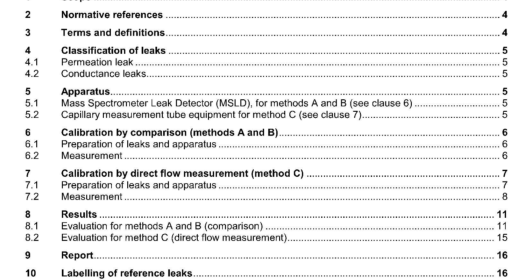BS EN 13192:2002 – Non-d estructive testing一Leak testing – Calibration of reference leaks for gases

4 Classification of leaks
4.1 Permeation leak This type of leak is normally made with a tracer gas reservoir. It has the best long-term stability but an appreciable temperature coefficient (approximately 3,5 %/K). Typical leakage rates are in the range from 10 – 10 Pa·m 3 /s to 10 -4 Pa·m 3 /s. 4.2 Conductance leaks 4.2.1 Capillary leak This type of leak is available with or without a tracer gas reservoir. It has a low temperature coefficient (approximately 0,3 %/K) but easily blocks if not handled with care. Typical leakage rates are greater than 10 -7 Pa·m 3 /s.
4.2.2 Aperture leak (orifice) Orifice leaks are seldom used in practice, as they are difficult to manufacture and even more prone to blocking than capillaries. 4.2.3 Compressed powder leak This type of leak uses metal powder compressed into a tube. They are usually offered without reservoir. They are used for routine check of the sensitivity of leak detectors but they are not stable enough to be used as calibration leaks. 5 Apparatus 5.1 Mass Spectrometer Leak Detector (MSLD), for methods A and B (see clause 6) To calibrate a leak by comparison to a known standard according to methods A and B described in clause 6, a mass spectrometer leak detector is necessary as the transfer device. Such a leak detector shall fulfil the minimum requirements for the measurement of leakage rate, laid down in EN 13625. The test port of the leak detector shall be equipped with an inlet system consisting of a set of ports with valves (preferably all metal) to couple the standard leak and the unknown leaks to the detection system and to shut off the leaks individually. The leak tightness of the inlet system shall be checked to a suitable level before a calibration is performed so that ambient tracer (e.g. helium of ambient atmospheric air) will not affect the measurement.
5.2 Capillary measurement tube equipment for method C (see clause 7) To calibrate a leak by measurement of capillary flow according to method C described in clause 7, a calibrated glass capillary tube (preferably with a suitable vent valve at one end, see Figure 1) is necessary. An indicator fluid (normally water with some surfactant added or special oils) is used to produce the measurement slug in the capillary.
To measure the time of slug movement, a timer or stopwatch will be needed. Instruments based on the timed movements of a film in a tube are also available, e.g. a bubble flow meter.
As conductance leaks normally have no tracer gas reservoir, a separate tracer gas supply is needed or calibration may be performed with filtered atmospheric air.
BS EN 13192:2002 – Non-d estructive testing一Leak testing – Calibration of reference leaks for gases